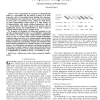Free Online Productivity Tools
i2Speak
i2Symbol
i2OCR
iTex2Img
iWeb2Print
iWeb2Shot
i2Type
iPdf2Split
iPdf2Merge
i2Bopomofo
i2Arabic
i2Style
i2Image
i2PDF
iLatex2Rtf
Sci2ools
TCBB
2008
2008
Efficient Algorithms for the Computational Design of Optimal Tiling Arrays
The representation of a genome by oligonucleotide probes is a prerequisite for the analysis of many of its basic properties, such as transcription factor binding sites, chromosomal breakpoints, gene expression of known genes and detection of novel genes, in particular those coding for small RNAs. An ideal representation would consist of a high density set of oligonucleotides with similar melting temperatures that do not cross-hybridize with other regions of the genome and are equidistantly spaced. The implementation of such a design is typically called a tiling array or genome array. We formulate the minimal cost tiling path problem for the selection of oligonucleotides from a set of candidates. Computing the selection of probes requires multi-criterion optimization, which we cast as a shortest path problem. Standard algorithms running in linear time allow us to compute globally optimal tiling paths from millions of candidate oligonucleotides on a standard desktop computer for most pro...
| Added | 15 Dec 2010 |
| Updated | 15 Dec 2010 |
| Type | Journal |
| Year | 2008 |
| Where | TCBB |
| Authors | Alexander Schliep, Roland Krause |
Comments (0)

